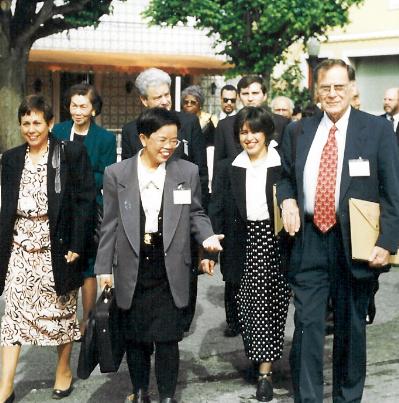Introduction and UNESCO's Mandate
Page 1
Yamousoukro and Seville Statement
Page 2
Origins and Executive Board Adoption
Pages 3 - 4
Launching the Programme: El Salvador and Roundtable
Pages 5 - 6 - 7
1993 General Conference
Page 8
National Projects
Pages 9 - 10
Programme Unit
Page 11
Toward a Global Scope
Pages 12 - 13
Transdisciplinary Project and Human Right to Peace
Pages 14 - 15 - 16
1997: A New Approach
Page 17
UN General Assembly Resolutions
Page 18
Resolution for International Year
Page 19
Declaration and Programme of Action
Pages 20 - 21
Resolution for International Decade
Pages 22 - 23
Training Programmes
Page 24
Global Movement
Pages 25 - 26
Publicity Campaign
Pages 27 - 28
Decentralized Network
Pages 29 - 30
Manifesto 2000
Page 31
Use of Internet
Pages 32 - 33
Future of the Culture of Peace
Pages 34 - 35 - 36 - 37 - 38
(continued from previous page)
The debate was sharp on 6 November at Commission V of the 1997 General Conference where the Human Right to Peace was on the Agenda (See synopsis in Annex V. Following a policy decision of the European Union, one European country after another expressed reservations about the Human Right to Peace, often couched in legalistic language. And countries from the South struck back, even accusing the North of wanting to protect their arms industries. At the end, Paraguay stated that "this rich discussion shows that the culture of peace is the central issue of this General Conference and that the Human Right to Peace is needed for individuals and states." Noting that the debate split North and South, Paraguay stated, "Perhaps peace is a greater concern in the South where scarce resources are being diverted to war." In the end, failing to achieve a consensus, the Director-General did not press further with the issue.
Skepticism about the Human Right to Peace continued to echo for years after the 1997 debate. In the informal discussions at the United Nations on 6 May 1999 concerning the Draft Declaration and Programme of Action on a Culture of Peace, the US delegate stated that "peace should not be elevated to the category of human right, otherwise it will be very difficult to start a war." The European Union, at the same session, while not expressing their objections as starkly, required the elimination of all reference to the culture of war.
I was also growing skeptical of the culture of peace, but for the opposite reason. While certain Member States were afraid it would be so effective that it might interfere with their "right" to make war, I was frustrated at its lack of effectiveness, at UNESCO's inability to have a real impact for peace at a grass roots or national level. As mentioned earlier, in my opinion the national programmes were failing, and they were not being replaced by anything more effective.
Given that UNESCO's priority is education, I tried another approach which was the launching of a global project for culture of peace and non-violence in schools. This got off to a good start at the International Forum in Sintra, Portugal, in May 1996 (See the Sintra Declaration). However, when it came time to follow-up, we encountered the same problems as those of national programmes; the staff position that had been established for direction of the project was "given away" at the very last moment by the Director-General for political considerations and the agency that had promised funds for the project did not make good on its promises.

 |
 |
 |